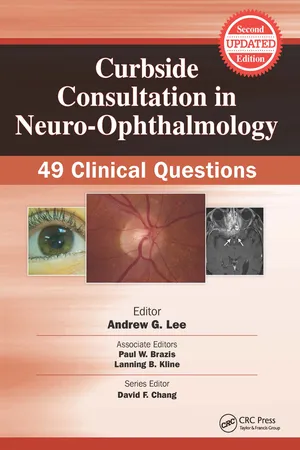
Curbside Consultation in Neuro-Ophthalmology
49 Clinical Questions
- 240 pages
- English
- ePUB (mobile friendly)
- Available on iOS & Android
Curbside Consultation in Neuro-Ophthalmology
49 Clinical Questions
About This Book
Curbside Consultation in Neuro-Ophthalmology has been updated into a Second Edition! The Second Edition contains new questions and is completely updated!
Curbside Consultation in Neuro-Ophthalmology: 49 Clinical Questions, Second Edition contains new questions and brief, practical, evidence-based answers to the most frequently asked questions that are posed during a "curbside consultation" between surgical colleagues. Dr. Andrew G. Lee and associate editors Dr. Paul W. Brazis and Dr. Lanning B. Kline have designed this unique reference in which neuro-ophthalmologists offer expert advice, preferences, and opinions on tough clinical questions commonly associated with neuro-ophthalmology. The unique Q&A format provides quick access to current information related to neuro-ophthalmology with the simplicity of a conversation between two colleagues. Images, diagrams, and references are included to enhance the text and to illustrate common clinical dilemmas. Some of the questions that are answered inside the Second Edition include:
- What is the evaluation for papilledema?
- What is the work up for third nerve palsy?
- What is the treatment for giant cell arteritis?
- What is the evaluation for optic disc edema with a macular star?
- What is the evaluation for anisocoria?
Curbside Consultation in Neuro-Ophthalmology: 49 Clinical Questions, Second Edition provides information basic enough for residents while also incorporating expert pearls that even high-volume ophthalmologists will appreciate. Residents, fellows, and practicing physicians alike will benefit from the user-friendly, casual format and the expert advice contained within.
Frequently asked questions
Information
Table of contents
- Cover
- Half Title
- Title Page
- Copyright Page
- Dedication
- Table of Contents
- Acknowledgments
- About the Editor
- About the Associate Editors
- Contributing Authors
- Introduction
- Question 1 How Should a Childhood Optic Nerve Glioma Be Worked Up?
- Question 2 How Should a Meningioma of the Optic Nerve Sheath Be Managed?
- Question 3 When Should You Consider the Diagnosis of Neuromyelitis Optica?
- Question 4 How Should I Evaluate and Manage Suspected Optic Neuritis?
- Question 5 What Is the Treatment of Optic Neuritis?
- Question 6 What Is the Workup and Treatment for Neuroretinitis?
- Question 7 How Do You Evaluate and Treat Nonarteritic Anterior Ischemic Optic Neuropathy?
- Question 8 How Do You Differentiate Arteritic From Nonarteritic Anterior Ischemic Optic Neuropathy?
- Question 9 How Should I Treat Giant Cell Arteritis?
- Question 10 What Is the Evaluation of Traumatic Optic Neuropathy?
- Question 11 What Is the Evaluation and Management for Papilledema?
- Question 12 Is There a Difference in the Management of Pseudotumor Cerebri in Pregnancy?
- Question 13 What Is the Evaluation and Management of Low- and High-Flow Carotid Cavernous Fistulas?
- Question 14 How Do I Work Up and Manage an Internuclear Ophthalmoplegia?
- Question 15 What Is the Workup and Treatment of Myasthenia Gravis?
- Question 16 How Do You Manage Visual Loss in Thyroid Eye Disease?
- Question 17 When Do You Use Radiation or Steroids in Thyroid Eye Disease?
- Question 18 How Do You Manage Diplopia in Thyroid Eye Disease?
- Question 19 What Are the Evaluations and Treatments for Acquired Nystagmus?
- Question 20 What Is the Evaluation for Anisocoria?
- Question 21 How and When Should I Work Up Horner Syndrome?
- Question 22 What Should I Do With a Dilated Pupil?
- Question 23 What Is the Evaluation for Episodic Anisocoria?
- Question 24 How Do You Manage Toxic and Nutritional Optic Neuropathies?
- Question 25 What Are Visual Processing Defects and How Can I Recognize Them?
- Question 26 How Do I Manage Patients With Headache Syndromes Who Come to Me as an Ophthalmologist?
- Question 27 What Is the Evaluation of Optic Atrophy?
- Question 28 How Do I Treat a Child With Asymmetric Nystagmus?
- Question 29 What Is Opsoclonus and How Do I Manage It?
- Question 30 What Is Wernicke Encephalopathy and How Does It Affect the Eye?
- Question 31 How Do I Manage Postoperative Visual Loss After Nonocular Surgery?
- Question 32 How Do I Manage Transient Monocular Visual Loss in a Young, Otherwise Healthy Patient?
- Question 33 What Is the Evaluation for Transient Monocular Visual Loss in an Older Adult?
- Question 34 What Is the Evaluation for a Homonymous Hemianopia?
- Question 35 What Is the Evaluation for a Painful Third Nerve Palsy Without a Fixed and Dilated Pupil but With Anisocoria (Partial Pupillary Involvement)?
- Question 36 How Do You Manage an Isolated and Presumed Vasculopathic, Pupil-Sparing Third Nerve Palsy?
- Question 37 What Is the Appropriate Evaluation of a Fourth Nerve Palsy?
- Question 38 What Is the Appropriate Evaluation in a Patient Suspected of Having a Sixth Nerve Palsy?
- Question 39 How Do I Evaluate a Patient With Multiple Ocular Motor Cranial Nerve Palsies?
- Question 40 What Is Blepharospasm?
- Question 41 What Is Hemifacial Spasm?
- Question 42 How Do You Deal With Nonorganic Visual Loss?
- Question 43 How Do You Diagnose and Manage Migraine Aura?
- Question 44 How Do I Recognize Leber Hereditary Optic Neuropathy?
- Question 45 How Do I Manage an Orbital Apex Syndrome?
- Question 46 How Do I Evaluate and Manage Idiopathic Orbital Inflammatory Syndrome?
- Question 47 How Do I Manage the Low-Flow Carotid Cavernous Fistula?
- Question 48 How Do I Evaluate and Treat Radiation Optic Neuropathy?
- Question 49 What Should I Do With a Seventh Nerve Palsy?
- Financial Disclosures
- Index